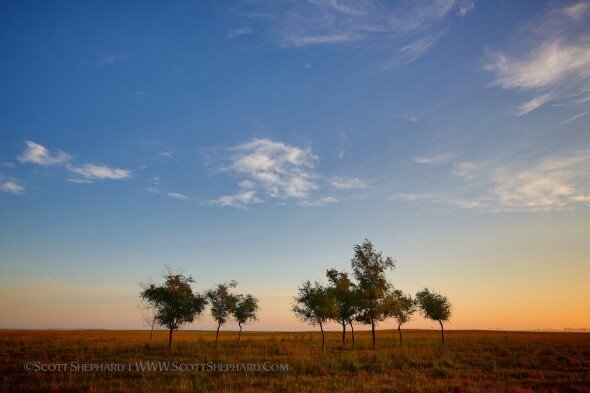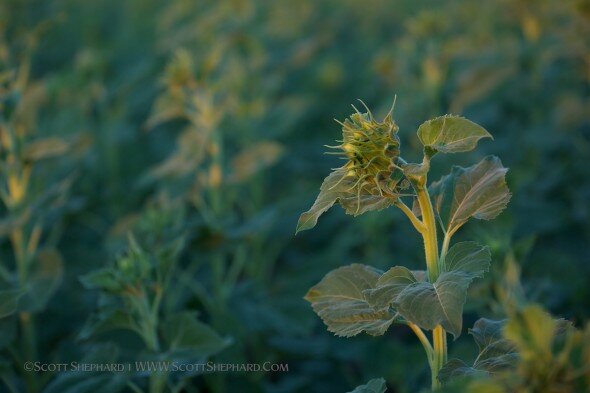 Yes, another sunflower shot. They are looking east, incidentally, away from the setting sun. And, yes, they look east all day and all night long. When I was a kid someone told me that they actually turned so they always faced the sun. That would be a form of heliotropism, so my high school biology teacher would say.But sunflowers aren't that ambitious.Canon 5DIII 1/80s f/7.1 ISO100 200mm
Yes, another sunflower shot. They are looking east, incidentally, away from the setting sun. And, yes, they look east all day and all night long. When I was a kid someone told me that they actually turned so they always faced the sun. That would be a form of heliotropism, so my high school biology teacher would say.But sunflowers aren't that ambitious.Canon 5DIII 1/80s f/7.1 ISO100 200mm
Landscape
08-14-12 Hand County, South Dakota
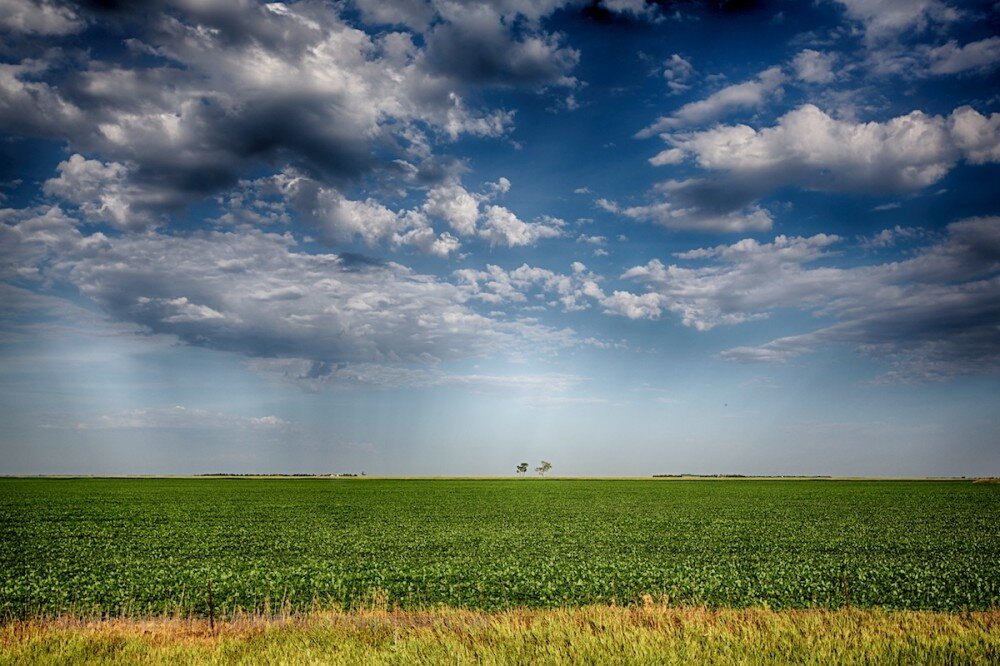 This is another HDR (high dynamic range) photo that is actually a combination of two photos. I'm not sure I like the dramatic "rays" that seem to be streaming to the ground from the clouds because I didn't see them when I took the photo. And they look a little unreal.But they are real. The HDR process only enhances and demonstrates what the camera "sees." As I was looking at this photo, wondering whether I should post it, it occurred to me that light is to a good camera what the high pitched dog whistle is to a dog: the camera and the dog perceive things much differently than humans do. And though cameras are tuned by humans to show us what humans normally see in terms of color, brightness and contrast, software processes allow us to see an alternate reality. In this case it is an HDR photo that shows us what shadows under clouds look like.On a side note, I took this photo where I did to pay homage to my mother- and father-in-law. Years ago they had a painting hanging over their couch that was a winter scene showing a prairie that was table flat and that stretched out to infinity. My mother-in-law said the picture reminded her of home, which was Hand County, South Dakota.Though it isn't winter yet in this scene, the landscape is certainly table flat.
This is another HDR (high dynamic range) photo that is actually a combination of two photos. I'm not sure I like the dramatic "rays" that seem to be streaming to the ground from the clouds because I didn't see them when I took the photo. And they look a little unreal.But they are real. The HDR process only enhances and demonstrates what the camera "sees." As I was looking at this photo, wondering whether I should post it, it occurred to me that light is to a good camera what the high pitched dog whistle is to a dog: the camera and the dog perceive things much differently than humans do. And though cameras are tuned by humans to show us what humans normally see in terms of color, brightness and contrast, software processes allow us to see an alternate reality. In this case it is an HDR photo that shows us what shadows under clouds look like.On a side note, I took this photo where I did to pay homage to my mother- and father-in-law. Years ago they had a painting hanging over their couch that was a winter scene showing a prairie that was table flat and that stretched out to infinity. My mother-in-law said the picture reminded her of home, which was Hand County, South Dakota.Though it isn't winter yet in this scene, the landscape is certainly table flat.
08-13-12 A Return To the Painted Trees
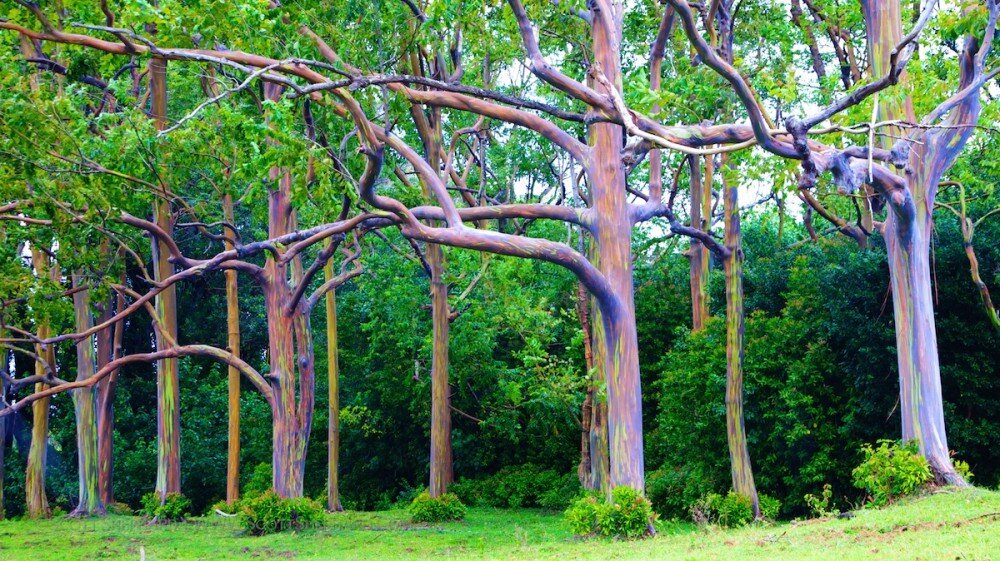 This is not the first post of these trees. But this photo offers a slightly different view and treatment. "Do they really look like that?" you ask. Well, I studied and taught philosophy just long enough to be confused by that question. So I'm not answering. . . .
This is not the first post of these trees. But this photo offers a slightly different view and treatment. "Do they really look like that?" you ask. Well, I studied and taught philosophy just long enough to be confused by that question. So I'm not answering. . . .
08-08-12 Ten Trees
08-04-12 Reflections
 I have photographed clouds reflected in this same water before. But I am a sucker for redundancy. This photo started out as a 5DIII picture but I imported it into Instagram and published it as the square, over filtered photo you see here. Some would say it's cheating to do Instagram photos with a camera not built in to a phone. And so I guess I cheat from time to time. :-(
I have photographed clouds reflected in this same water before. But I am a sucker for redundancy. This photo started out as a 5DIII picture but I imported it into Instagram and published it as the square, over filtered photo you see here. Some would say it's cheating to do Instagram photos with a camera not built in to a phone. And so I guess I cheat from time to time. :-(
08-03-12 Dawn
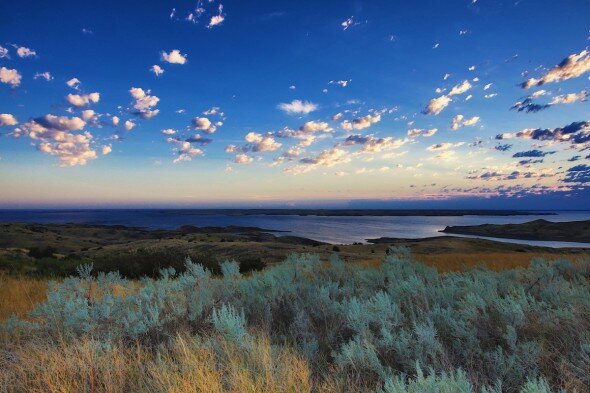 Here's another HDR photo taken from the bluffs overlooking the northern leg of the Little Bend on Lake Oahe. In the shot I posted a while back I was looking east into the rising sun. In this shot, I've moved my tripod, the sun is behind me and I am looking off to the northwest towards the Cheyenne River.I don't know about you, but when I look at this photo I see the pure white of the popcorn clouds. Then I see the sea green sage and, finally, the distant, dark water and long line of the cloud covered horizon. (And if you are paying attention to words here, I hope you appreciate my alliterative attempts. Opps, I did it again. :-) Or did I? Actually, "alliterative attempts" is an example of assonance. Sorry, but I was an English teacher long before I started to call myself a photographer.)
Here's another HDR photo taken from the bluffs overlooking the northern leg of the Little Bend on Lake Oahe. In the shot I posted a while back I was looking east into the rising sun. In this shot, I've moved my tripod, the sun is behind me and I am looking off to the northwest towards the Cheyenne River.I don't know about you, but when I look at this photo I see the pure white of the popcorn clouds. Then I see the sea green sage and, finally, the distant, dark water and long line of the cloud covered horizon. (And if you are paying attention to words here, I hope you appreciate my alliterative attempts. Opps, I did it again. :-) Or did I? Actually, "alliterative attempts" is an example of assonance. Sorry, but I was an English teacher long before I started to call myself a photographer.)
08-02-12 Good Soldiers
08-01-12 Feed Me, Seymour
07-31-12 Waiting for the Sun
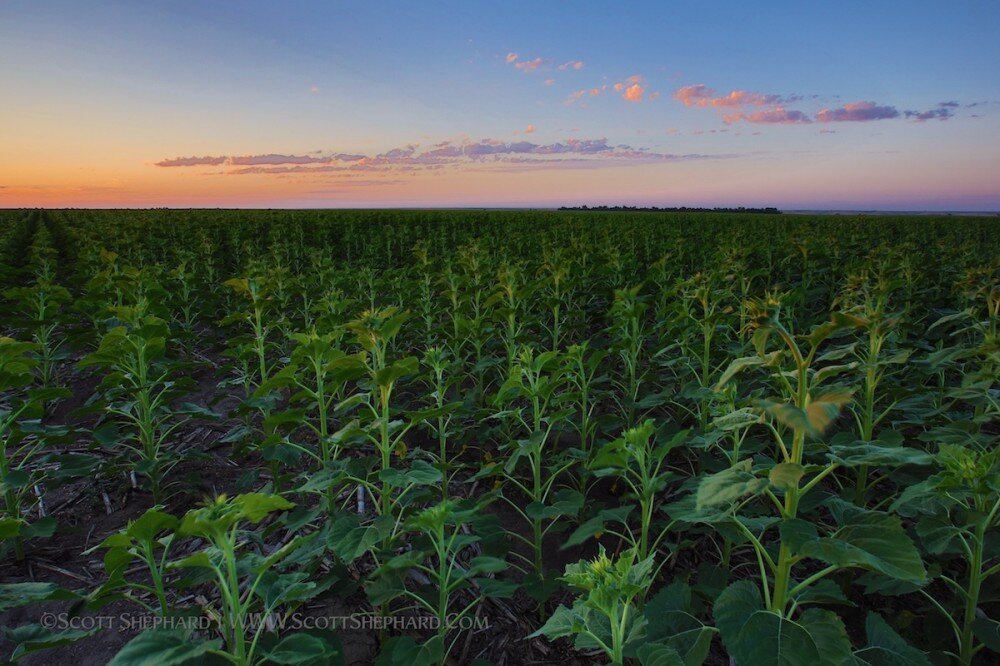 So who takes photos of sunflowers before they bloom? I guess I do, though I'll admit that it was a total afterthought yesterday morning. I was finished with the tree, clouds, and sunrise photos and as I headed back to the truck, I noticed the field of nascent sunflowers that was next to the field I had been standing in.What I liked was the deep green hues of the plants. I also liked the amazing textures in the sunflower heads. And so I took about 40 photos of sunflowers not in bloom. This is the first in a series of three. Bear with me if you're not into green things. . .
So who takes photos of sunflowers before they bloom? I guess I do, though I'll admit that it was a total afterthought yesterday morning. I was finished with the tree, clouds, and sunrise photos and as I headed back to the truck, I noticed the field of nascent sunflowers that was next to the field I had been standing in.What I liked was the deep green hues of the plants. I also liked the amazing textures in the sunflower heads. And so I took about 40 photos of sunflowers not in bloom. This is the first in a series of three. Bear with me if you're not into green things. . .
07-22-12 Glorious
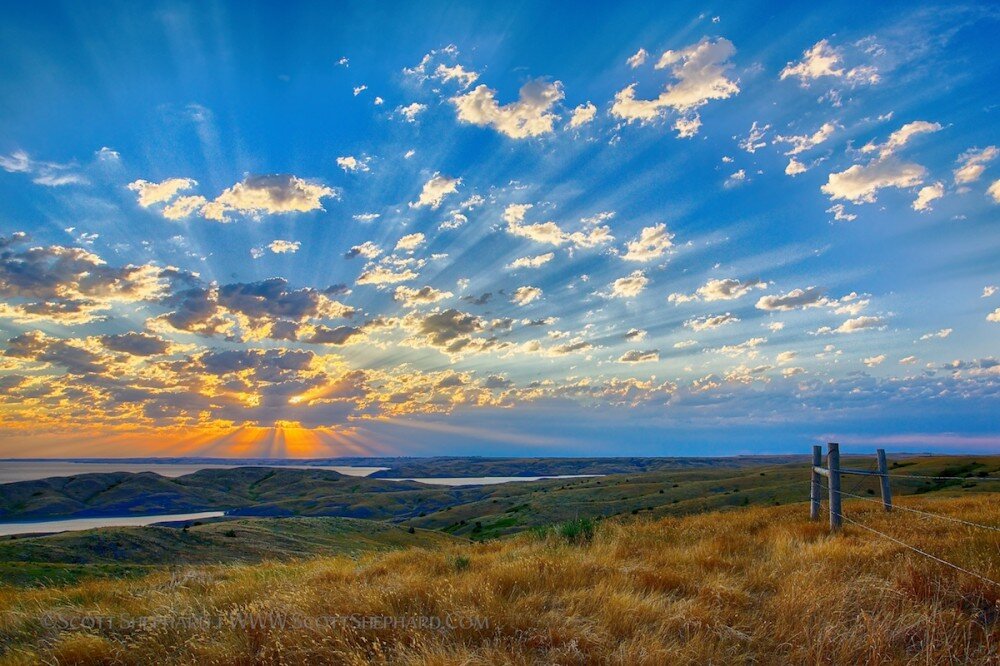 Sometimes, when I'm out at Lake Oahe in central South Dakota, I don't go sailing. On this particular morning, I woke up well before sunrise and at first light saw that there were some clouds off in the east that looked promising. So I packed up my camera gear and went driving. I ended up on the bluffs above the Little Bend area - an area I have been to many times before.It may seem obvious but a sunrise photo isn't about the sun - that looks pretty much the same every time. It's about the clouds, the terrain and the atmosphere. And in all of these cases, I got what I was looking for.This photo, incidentally, is an HDR photo, which means that it's really two or three photos sandwiched together into one. I experimented with a process that gives this photo a bit of a surreal look. Compositionally, this photo does what a landscape photo should do: there is something in the foreground, the middle ground and in the back ground.I wish you could have been with me when I took this photo. It was an amazing moment in an very special place.Canon 5DIII f/8.0 1/250 ISO400 19mm
Sometimes, when I'm out at Lake Oahe in central South Dakota, I don't go sailing. On this particular morning, I woke up well before sunrise and at first light saw that there were some clouds off in the east that looked promising. So I packed up my camera gear and went driving. I ended up on the bluffs above the Little Bend area - an area I have been to many times before.It may seem obvious but a sunrise photo isn't about the sun - that looks pretty much the same every time. It's about the clouds, the terrain and the atmosphere. And in all of these cases, I got what I was looking for.This photo, incidentally, is an HDR photo, which means that it's really two or three photos sandwiched together into one. I experimented with a process that gives this photo a bit of a surreal look. Compositionally, this photo does what a landscape photo should do: there is something in the foreground, the middle ground and in the back ground.I wish you could have been with me when I took this photo. It was an amazing moment in an very special place.Canon 5DIII f/8.0 1/250 ISO400 19mm
07-17-12 Spring Wheat
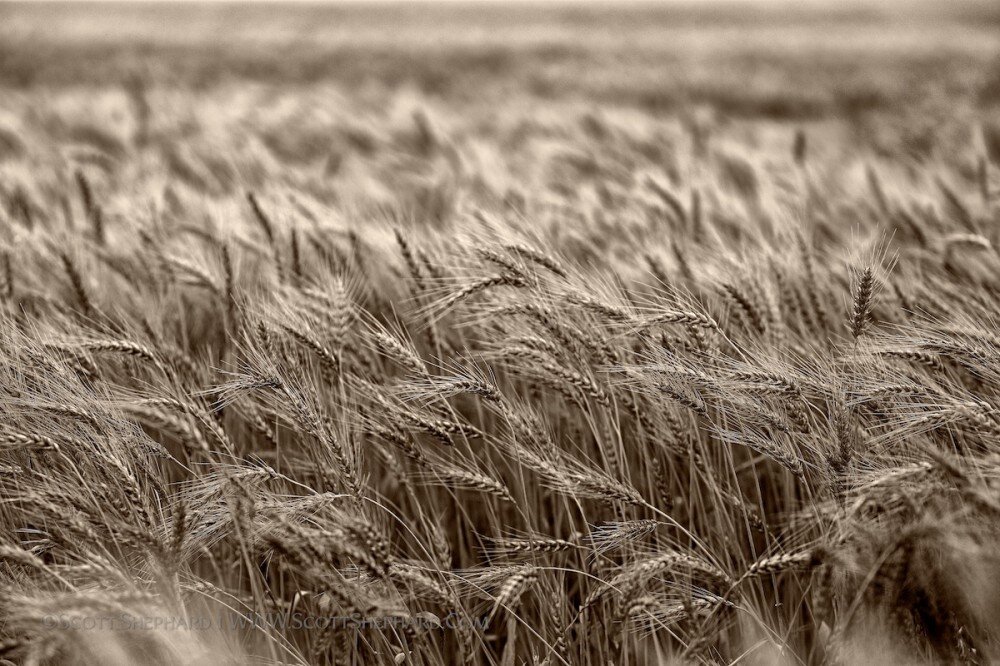 Some would say that if you've seen one wheat field, you've seen them all. And from a distance that's probably true. But I'm afraid my quest for good wheat photos yesterday didn't satisfy me. So I went out again this morning looking again for the perfect wheat photo opportunity. I was hoping for better light today and I got it. Generally, it was overcast but the sun was working to push its way through occasional soft spots in the morning clouds. And so I got the perfect back lighting from the biggest soft box on earth.I took over 200 photos during the 30 minutes I spent at this particular field. I'll admit that I was practicing a little "spray and pray" photography because a gusty breeze was causing the heavy heads of wheat to move around. And since I was using a very narrow field of focus (low f-stop number), I wanted to be sure I had some focused photos when I got home.Towards the end of my shoot, Bret H., the field's owner, drove up and stopped. I walked over to his truck with my camera and told him that I couldn't resist taking photographs of his amazing crop. He simply smiled. When I showed him a photo I had just taken and said, "You're not a farmer; you're an artist," he smiled some more.If you haven't stopped by a mature wheat field and studied the plant that in some ways was and still is the foundation of western civilization, it's time you did. The whispy "hairs" and the braid-like grains of wheat truly are a work of art.
Some would say that if you've seen one wheat field, you've seen them all. And from a distance that's probably true. But I'm afraid my quest for good wheat photos yesterday didn't satisfy me. So I went out again this morning looking again for the perfect wheat photo opportunity. I was hoping for better light today and I got it. Generally, it was overcast but the sun was working to push its way through occasional soft spots in the morning clouds. And so I got the perfect back lighting from the biggest soft box on earth.I took over 200 photos during the 30 minutes I spent at this particular field. I'll admit that I was practicing a little "spray and pray" photography because a gusty breeze was causing the heavy heads of wheat to move around. And since I was using a very narrow field of focus (low f-stop number), I wanted to be sure I had some focused photos when I got home.Towards the end of my shoot, Bret H., the field's owner, drove up and stopped. I walked over to his truck with my camera and told him that I couldn't resist taking photographs of his amazing crop. He simply smiled. When I showed him a photo I had just taken and said, "You're not a farmer; you're an artist," he smiled some more.If you haven't stopped by a mature wheat field and studied the plant that in some ways was and still is the foundation of western civilization, it's time you did. The whispy "hairs" and the braid-like grains of wheat truly are a work of art.
07-16-12 Amber Waves
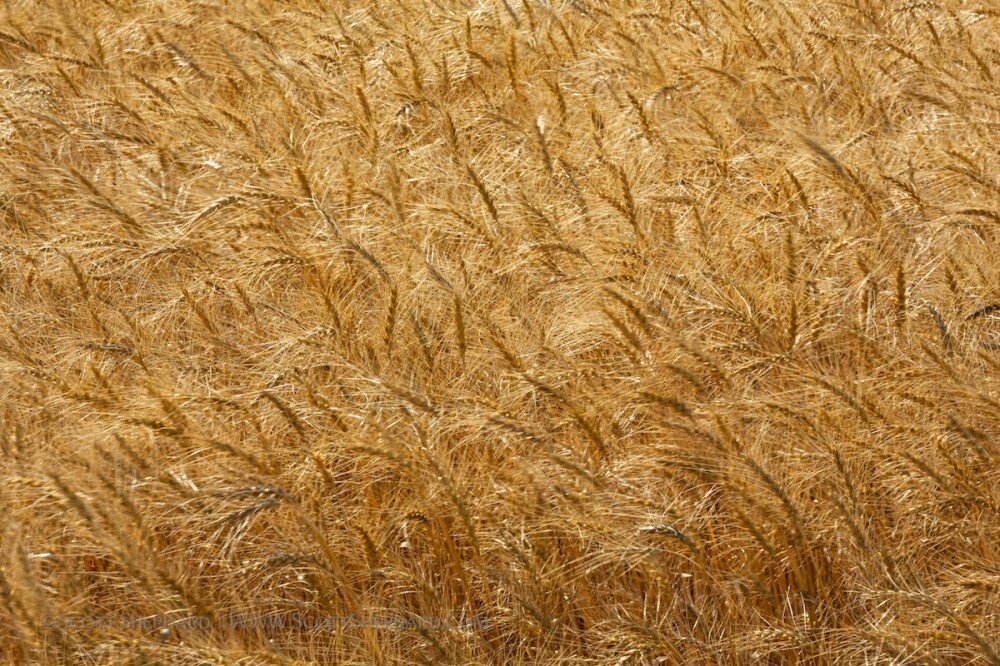 When I went driving this morning in search of something to photograph, I figured that the perfect wheat field would likely draw me like a magnet. I am fascinated by bare, black fields that turn to green and then to beautiful yellow-gold. And we can't help but notice the harvest of wheat because the huge red or green machines that work the fields contrast so distinctly with the mature crop.But who has the time or interest to park and take a closer look at the grain? I would guess the farmer would. And so does the photographer, who, as I've said so many times in this blog, has the power to get you, the viewer, to take a closer look. And it is worth the time. . .
When I went driving this morning in search of something to photograph, I figured that the perfect wheat field would likely draw me like a magnet. I am fascinated by bare, black fields that turn to green and then to beautiful yellow-gold. And we can't help but notice the harvest of wheat because the huge red or green machines that work the fields contrast so distinctly with the mature crop.But who has the time or interest to park and take a closer look at the grain? I would guess the farmer would. And so does the photographer, who, as I've said so many times in this blog, has the power to get you, the viewer, to take a closer look. And it is worth the time. . .

